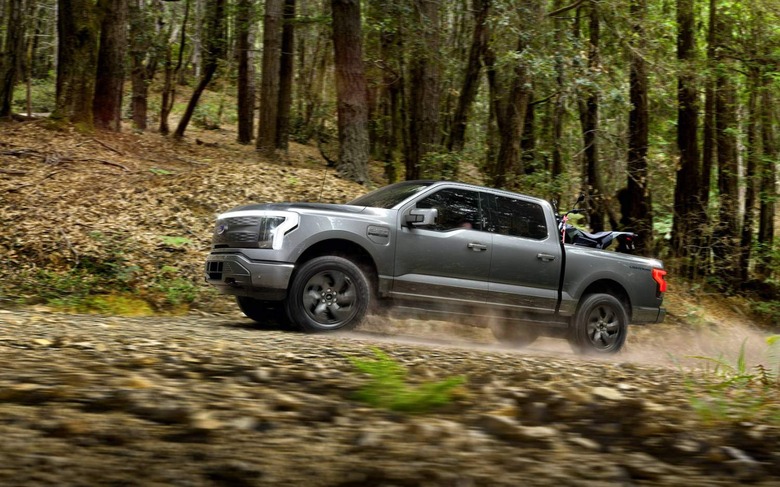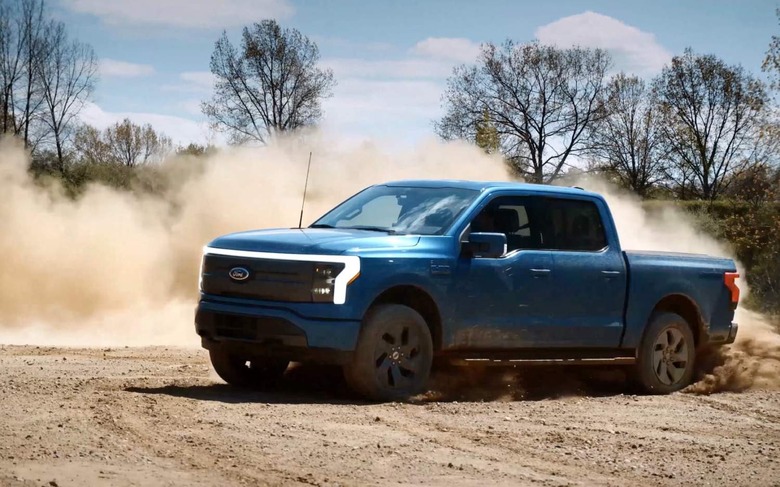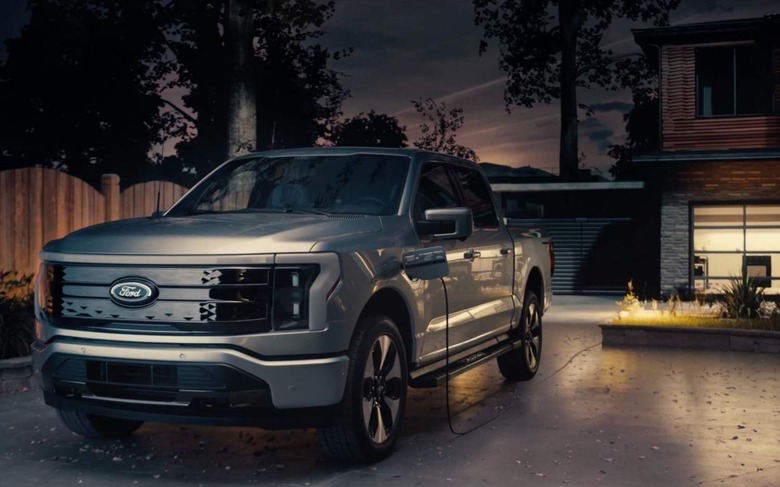Ford's Most Outrageous F-150 Lightning Feature Is Right In Front Of You
Ford's new electric pickup doesn't look like a spaceship, or a movie prop, it looks like an F-150. It feels a little weird that normality alone leaves the F-150 Lightning an outlier in the fledgling EV truck segment, but then Ford's challenge is arguably a very different one to that faced by Tesla, Rivian, Canoo, and others.
Indeed you could argue that the closest parallel will be Chevrolet's upcoming electric Silverado, though so far we've only seen a badge for that pickup EV. The rest of the electrified truck segment has opted for more outlandish aesthetics, whether that's Elon Musk's stealth-bomber inspired Cybertruck, Canoo's cab-forward pickup, or GMC's sci-fi Hummer EV.
Were any of them actually in production yet, you could probably park the 2022 F-150 Lightning among them and hardly notice it. Certainly, it's the most "normal" of the electric trucks we've been promised. A close sibling to the gas F-150, rather than a revolutionary cousin.

There are differences between the models, of course. The F-150 Lightning blanks out a lot of the regular F-150's grilles, as its ventilation needs are different and often aerodynamics take priority. Its body is smoother in some places, and punctuated by more striking LEDs in others. Still, with its three-box format and kinked shoulder line, it couldn't be anything other than an F-150.
Instead, what stands out is that Ford's evolutionary design – or, at least, the F-150 Lightning's skin-deep changes – isn't from lack of imagination, or indeed laziness. The electric pickup looks like an F-150 because Ford needs buyers to know it is an F-150. This isn't some new brand, needing all the help it can get to claw attention in a crowded market. Owners already love the F-150: Ford needs them to love electric, too.
Truck buyers can be a conservative bunch. You only need look back to 2014, and the kid-glove approach Ford took when it made the controversial switch from steel to aluminum for the 13th generation F-150's body, to see just how cautiously the more traditional automakers handle them. Braced for comparisons with beer cans and foil takeout containers, Ford went to incredible lengths to underscore just how sturdy its "military-grade aluminum" was, lest longstanding fans of the pickup decided it was no longer Built Ford Tough.

Sales, rising EPA fuel economy ratings, and rivals – some of whom publicly sneered initially – following suit have since demonstrated the wisdom of Ford's decision. All the same, it's a reminder of just how careful you need to be when you're introducing a huge change to your best-selling product.
Ford is coy on how many new-to-F-150 buyers it expects to climb behind the wheel of the electric version, and how many could transition over from a gas model instead. The fact is, though, that the automaker has done plenty to ensure that switch is as straightforward as possible. Ford engineers and designers were embedded with existing F-150 owners as they crafted the EV, making sure both that it would offer features that resonated with how they wanted to use their trucks, and that it didn't in the process remove something they might miss.
So, though there are aesthetic updates inside and out, the cabin and bed dimensions remain the same: existing F-150 accessories will work with the F-150 Lightning, too. Owners like having a physical transmission shifter, and so the F-150 Lightning keeps that as well, even though Ford could've saved space and complexity with buttons or a rotary selector.
Telling the electric story can be a challenge, even if your audience is one of eager early-adopters. Battery capacity, charging connectors and speeds, and the nuances of DC fast charging and regenerative braking alone can be overwhelming in any degree of detail. Ford's strategy – of leaving familiar what can be left that way – seems a wise one, reserving what attention potential drivers can spare in order to pitch the key advantages of electrification rather than trying to justify why it's just as good as what they're used to.

A vast front trunk. Instantaneous torque. The ability to power a worksite – or a home – with no noise and no pesky carbon monoxide to consider. They're a shortlist of highlights that will help get potential owners through the dealership door. Beyond that, well, it's a known fact that once people experience the instant acceleration of an EV, they tend to be a lot more amenable to the idea of driving one every day.
In the end, the F-150 Lightning's most important rival isn't Elon Musk's Cybertruck, or even upstarts like Canoo and Rivian with their electric pickups. It's actually the existing F-150 with its familiar combustion engines, familiar driving dynamics, and familiar "I fill it with gas and I drive it to work" ownership experience. If Ford can sell that truck-as-a-tool audience on electrification as an upgrade to all that, not just an alternative, then the 2022 F-150 Lightning could well be the most important F-Series in decades.
